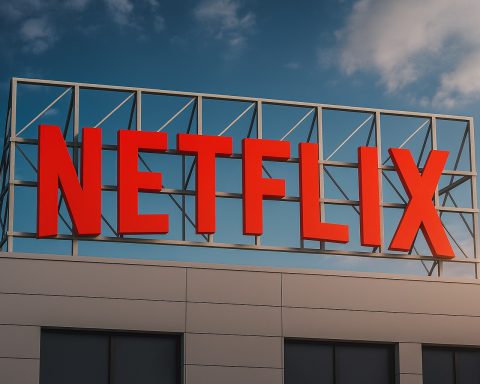Verizon stock is back in focus this morning as Wall Street digests a massive restructuring plan, fresh layoffs, new CEO Dan Schulman’s strategy, and the company’s ambitious bet on fiber and satellite connectivity. Here’s a concise pre‑market briefing on Verizon Communications Inc. (NYSE: VZ) for Friday, November 14, 2025.
Snapshot: How Verizon Stock Looks Before the Bell
- Ticker: VZ (NYSE)
- Thursday close (Nov. 13): About $41.10–$41.11, up roughly 0.7–0.8% on the day. [1]
- Indicated pre‑market (around early US morning): Trading in the low $41s, modestly higher than Thursday’s close (around +0.5–0.8%), according to extended‑hours indications. [2]
- Market cap: ~$173 billion. [3]
- Valuation: Forward P/E around 8–9x, below the broader market, with a dividend yield near 6.7–6.8% following a recent dividend increase to $0.69 per quarter. [4]
For context, the broader US market ended Thursday sharply lower, with major indexes hit by a tech-led sell‑off, even as more defensive, high‑yield names like Verizon held up better. [5]
The Big Story: Up to 15,000 Job Cuts and a Historic Restructuring
The headline for Verizon stock today is clear: a huge cost‑cutting plan under its new CEO.
Multiple reports from Reuters, The Wall Street Journal and others say Verizon plans to cut around 15,000 jobs, roughly 15% of its global workforce, in what is expected to be the company’s largest‑ever round of layoffs. [6]
Key points from the restructuring reports:
- Scope of cuts: About 15,000 roles, with more than 20% of non‑union management positions at risk. [7]
- Retail footprint changes: Around 180–200 Verizon‑owned retail stores are expected to be converted into franchise locations, shifting more risk and cost to third‑party operators. [8]
- Timing: Layoffs could begin as soon as next week, meaning investors should expect more detail from management imminently. [9]
An in‑depth analysis from AInvest characterizes this as “one of the most aggressive restructuring plans” in Verizon’s history, aimed squarely at cost efficiency and operational flexibility as the company grapples with slow revenue growth and intense competition from AT&T, T‑Mobile and cable players. [10]
So far, the market reaction has been cautiously positive. Several outlets note that Verizon stock rose roughly 0.7–1% on Thursday, even as broader indices sold off, suggesting investors are initially welcoming the promise of improved margins—even if it comes with heavy human and reputational costs. [11]
What it means for investors today:
- In the short term, layoffs usually translate into expectations of higher free cash flow and margin expansion, a positive for a high‑dividend stock like VZ.
- In the medium term, the risk is execution: if cuts damage service quality or morale, Verizon could lose subscribers just as competitors are pushing aggressively into 5G and home broadband. [12]
New CEO Dan Schulman: The Turnaround Architect
Today’s pre‑market narrative on Verizon stock can’t be separated from its leadership shake‑up.
- Verizon appointed Dan Schulman, best known as the former CEO of PayPal and a veteran of Virgin Mobile, as its new chief executive in October 2025, replacing Hans Vestberg. [13]
- Reports suggest the board grew frustrated after two consecutive quarters of losses and expectations for a third, deciding a more radical strategic shift was needed. [14]
In his early public comments and during the Q3 earnings call, Schulman has laid out a few clear priorities: [15]
- Customer‑first focus – Moving away from a purely “network‑first” philosophy to one centered on simplifying offers, removing friction from the customer experience, and using AI to streamline plans and support.
- Lean, less bureaucratic organization – Cutting layers of management and speeding up decision‑making.
- Disciplined capital allocation – Focusing capital on areas with the clearest return: 5G, fiber, bundled mobile + broadband offerings, and high‑value enterprise services.
The layoff plan and store franchising push are being interpreted as Schulman’s first major “marker”—his way of showing he’s serious about reshaping Verizon’s cost base and culture. [16]
For Verizon stock, this is a classic turnaround story: the upside is substantial if Schulman can spark growth and efficiency simultaneously, but the margin for error is limited in a saturated wireless market.
Frontier Deal and $11 Billion in Bonds: Bigger, But Also More Leveraged
Another crucial piece of today’s Verizon story is its pending $20 billion acquisition of Frontier Communications, a major US fiber and broadband provider that would significantly expand Verizon’s wireline footprint. [17]
Recent developments:
- Verizon has sold about $11 billion of investment‑grade bonds to help fund the Frontier deal, issuing the debt in five tranches, including a long‑dated 40‑year bond. [18]
- The company had previously arranged approximately $10 billion in short‑term bank financing; the new bond deal moves that toward permanent funding. [19]
- The acquisition values Frontier at around $20 billion including debt, with closing targeted for early 2026, subject to remaining regulatory approvals—most notably from California regulators. [20]
At the end of Q3, Verizon already carried about $146.8 billion in total debt, but credit agencies like Fitch still rate its long‑term debt at A‑ with a stable outlook, citing strong cash generation and scale. [21]
Investor takeaway before the open:
- The Frontier deal, combined with the layoff plan, is part of a bigger strategic bet: use scale in mobile plus fiber broadband to push converged bundles and lock in customers. [22]
- But it also means higher leverage and less room for error if revenue growth continues to lag. Investors will be watching how ratings agencies and bond markets react to the restructuring news.
Network Moves: Towers, Satellites and 5G Capacity
Even amid aggressive cost cuts, Verizon is not pulling back on network investments—another tension traders are weighing this morning.
Long‑term tower agreement with SBA Communications
On November 3, Verizon announced a new long‑term agreement with SBA Communications, a major US tower operator. The deal gives Verizon more favorable economics and flexibility across SBA’s nationwide tower portfolio, supporting continued expansion of its 4G and 5G services. [23]
The agreements are framed as:
- Locking in cost certainty on towers over many years.
- Allowing Verizon to optimize where and how it deploys radios, improving coverage and capacity while controlling expenses.
For VZ shareholders, this underpins the idea that Verizon can both cut overhead and keep investing in the network “plumbing” that underlies its brand promise.
Space‑based broadband with AST SpaceMobile
Earlier in October, AST SpaceMobile shares jumped after announcing a definitive commercial agreement with Verizonto deliver space‑based cellular broadband across the continental US starting in 2026. Verizon will contribute part of its premium 850 MHz low‑band spectrum, enabling direct‑to‑device connectivity from AST’s low‑Earth‑orbit satellite constellation. [24]
The partnership could:
- Extend Verizon coverage to remote and underserved areas where traditional towers are impractical.
- Strengthen Verizon’s positioning for emergency communications and rural broadband, themes regulators increasingly care about.
These network moves may not move the stock intraday, but they are important context when evaluating today’s negative headline (layoffs) against the company’s longer‑term growth opportunities.
Q3 2025 Results: Still Looming in the Background
Although today’s trade will be driven by layoffs and restructuring, the market is still digesting Verizon’s Q3 2025 earnings, reported at the end of October.
Highlights from recent filings and earnings coverage: [25]
- Earnings beat:
- EPS came in around $1.21, just above consensus of roughly $1.19.
- Revenue softness:
- Quarterly revenue of about $33.8 billion narrowly missed Wall Street expectations (~$34.2 billion), but was still up around 1.5% year‑over‑year.
- Dividend increase:
- Verizon raised its quarterly dividend from $0.68 to $0.69, implying an annualized yield near 6.7% at current prices.
- Wireless performance:
- Wireless service revenue continues to grow modestly, but net subscriber additions lag peers, especially versus T‑Mobile’s strong postpaid gains.
The Q3 numbers paint a picture of a cash‑rich but growth‑challenged incumbent—a backdrop that helps explain the urgency behind Schulman’s restructuring plan.
Institutional Money: Who Is Buying Verizon Stock?
Fresh 13F filings published today highlight steady institutional interest in Verizon:
- Candriam S.C.A. increased its stake by about 2.2% in Q2 to 422,583 shares, valued around $18.3 million, and notes that institutional investors in aggregate own just over 62% of the float. [26]
- Impax Asset Management Group opened a new position of roughly 33,000 shares (~$1.43 million). [27]
- Arvest Bank Trust Division initiated a stake of about 16,143 shares (~$699,000). [28]
These holdings are small relative to Verizon’s size but reinforce the perception of VZ as a core dividend and income holding among long‑term institutional investors—even as the stock trades through a noisy transition.
How Wall Street Rates Verizon Stock Right Now
Heading into today’s session, the analyst picture is mixed but leaning slightly positive:
- MarketBeat tracks 21 Wall Street analysts with a consensus rating of “Hold” and an average 12‑month price target of about $47.41, implying roughly 15% upside from around $41.10. [29]
- Public.com’s aggregation of 11 analysts shows a “Buy” consensus, with a price target near $48.45. [30]
- GuruFocus data points to a P/E around 8.8, net margin in the mid‑teens, and an Altman Z‑Score that places Verizon in a higher‑risk “distress zone”, highlighting that leverage and growth concerns are very real. [31]
In other words, analysts generally see moderate upside and a healthy dividend, but not without risk. Some firms have downgraded the stock in recent months, citing weak subscriber trends and a crowded competitive field. [32]
Macro Backdrop: Defensive Telecom in a Volatile Market
Yesterday’s broader market action matters for VZ this morning:
- Major US indices closed sharply lower on November 13, with tech and momentum names leading the decline. [33]
- Amid this, Verizon’s stock finished higher, and commentary from financial outlets notes that investors may be rotating into high‑yield, lower‑beta names as volatility returns. [34]
Telecoms, however, are not bond proxies anymore: they are capital‑intensive, competitively pressured businesses. Verizon’s combination of rich yield, modest growth and elevated leverage makes today’s restructuring news a key catalyst for how defensively the stock actually trades in a sustained downturn.
What to Watch on Verizon Stock Today
Going into the US market open on November 14, 2025, here are the key questions traders and longer‑term investors will be asking:
- Market reaction to layoffs
- Does the stock extend Thursday’s gains as investors focus on cost savings, or does it fade as concerns about execution, morale and brand risk sink in?
- Street commentary and rating changes
- Watch for new analyst notes or rating actions reacting to the 15,000‑job cut plan and the deeper restructuring narrative.
- Bond‑market signals
- Verizon just tapped the market for $11 billion in bonds tied to the Frontier deal—any sign of widening spreads or concern from credit investors could weigh on the equity. [35]
- Read‑through to peers
- AT&T, T‑Mobile, Comcast and Charter may move in sympathy, as investors reassess the competitive dynamics in US wireless and broadband following Verizon’s aggressive cost actions. [36]
- Options and short‑term flows
- With November 14 options expiring today, short‑dated VZ calls and puts may add extra volatility intraday as traders reposition around the news backdrop. [37]
Bottom Line
Before the opening bell on November 14, 2025, Verizon stock sits at the intersection of three powerful forces:
- A historic restructuring and layoff plan that could materially improve margins—but also carries real operational and reputational risks. [38]
- A strategic expansion via the Frontier acquisition, new tower leases and satellite partnerships that deepen Verizon’s network moat but increase leverage. [39]
- A valuation story—low P/E, high yield, and moderate upside in analyst targets—that makes VZ look attractively priced if Schulman’s turnaround works. [40]
For traders today, the question is how much of this new reality is already priced in. For long‑term investors, the focus is whether Verizon can convert bold cost cuts and big network bets into durable growth—without breaking what customers value most: reliable service.
Disclaimer: This article is for informational purposes only and does not constitute financial advice, investment recommendation, or an offer to buy or sell any securities. Always do your own research or consult a licensed financial adviser before making investment decisions.
References
1. www.marketbeat.com, 2. www.marketbeat.com, 3. www.marketbeat.com, 4. www.marketbeat.com, 5. www.investopedia.com, 6. www.reuters.com, 7. www.reuters.com, 8. seekingalpha.com, 9. www.reuters.com, 10. www.ainvest.com, 11. www.indmoney.com, 12. www.ainvest.com, 13. www.reuters.com, 14. www.gurufocus.com, 15. www.customerexperiencedive.com, 16. www.investors.com, 17. www.investors.com, 18. www.telecoms.com, 19. www.telecoms.com, 20. www.telecoms.com, 21. www.telecoms.com, 22. www.telecoms.com, 23. www.verizon.com, 24. 247wallst.com, 25. www.marketbeat.com, 26. www.marketbeat.com, 27. www.marketbeat.com, 28. www.marketbeat.com, 29. www.marketbeat.com, 30. public.com, 31. www.gurufocus.com, 32. www.marketbeat.com, 33. www.investopedia.com, 34. www.morningbrew.com, 35. www.telecoms.com, 36. www.reuters.com, 37. investorshub.advfn.com, 38. www.reuters.com, 39. www.telecoms.com, 40. www.marketbeat.com







